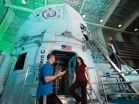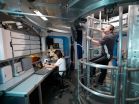HOUSTON, TX, March 19, 2014 (Press-News.org) If two is company and three is a crowd, what is four - especially when you are living and working in close quarters and under stress for several days? That is what NASA's Flight Analogs Project, funded by NASA's Human Research Program, set to find out when it sent four crew members on a simulated mission to the Geographos asteroid on February 27, 2014. This initiated the first of many missions that will take place inside the Human Exploration Research Analog (HERA) located at NASA's Johnson Space Center.
"Flight analogs like HERA provide researchers with environments that emulate spaceflight conditions," said Joe Neigut, project manager of NASA's Flight Analog Project. "We use analogs to better understand the impacts of spaceflight on the human body."
In this case, investigators conducted behavioral health, human factors and countermeasures experiments on the four crew members who were crowded into the 148-cubic-meter HERA to determine how confinement and isolation impacts cohabitation, teamwork, team cohesion, mood, performance and overall well-being.
Crew members were told that their asteroid exploration mission would validate the technologies and operational methodologies necessary to ensure the option for future asteroid mining. During their seven-day mission, they worked and lived in cramped quarters equipped with four bunks, a work area, a hygiene area and an airlock.
They were assigned operational tasks similar to those performed by astronauts on the International Space Station; however, the tasks were modified to emulate what might be required on a mission to an asteroid. They included general housekeeping, maintenance and systems tasks, education and outreach activities, daily planning conferences, and family and medical conferences. Crew members also conducted payload objectives (experiments) related to biology, geology and robotics, participated in onboard training, ate the same food as crew members aboard the space station, and exercised.
"The first 48 hours were jam-packed with tasks," said crew member Jared Daum.
According to crew members, the full schedule of tasks helped them completely immerse themselves in the mission. "We really felt like we were in space," said crew member Jessica Vos.
While crew members were busy with their daily tasks, researchers were gathering data about them for 10 investigations.
For one investigation, crew members wore electronic badges that recorded heart rate, distance, motion, sound intensity, proximity and interactions between crew members who were solving problems together. This data provided investigators with insight into team cohesion.
Researchers also studied well-being, interaction and reaction to stress by analyzing crew member language. They did this by recording interactions and analyzing them using special software. They also conducted crew member surveys and analyzed their written language.
"The use of some words can indicate things like early depression, anxiety and anger," said Susi Zanello, Ph.D. and Flight Analogs Project deputy project scientist.
Another investigation studied mood using optical computer recognition, examining crew members' facial expressions while they completed tasks in front of a camera. As with language, specific facial expressions can signal various attitudes, emotional states and even fatigue.
Researchers also looked for specific biomarkers in crew member saliva to determine if team performance and cooperation were correlated with specific hormone levels induced by demands such as extended work days, variable workloads, communication delays, vague procedures, and equipment malfunctions that were built into the mission to ensure it had the normal fluctuation of crew stress that one would expect in a real flight or exploration mission.
Implementing these types of tests in space can prove difficult because of limitations on the type of equipment that can be used, the cost to fly the equipment to space and the limited number of test subjects. Analog testing compensates for the limitations of these constraints.
"Conducting investigations like these in an analog setting versus in space is more efficient both in regard to cost and time," said Neigut.
But what can scientists learn about how limiting elbow room affects mood and behavior in just seven days?
"These studies are all in exploratory mode," explained Zanello. "While all of the approaches provide useful information about the characteristics of teams and good teamwork, this HERA mission is really a proof of concept for technologies that we may consider using in longer duration analog missions."
In fact, while three more seven-day HERA missions are planned, Flight Analogs Project personnel are already conceiving missions of up to 30 days in duration.
"We plan to increase the fidelity and duration of the missions over time," said Neigut.
Although future missions may be long on time one thing is certain, HERA crew members will continue to be short on space.
Give Me Some 'Space'!
NASA studies effects of confinement and isolation.
2014-03-19
ELSE PRESS RELEASES FROM THIS DATE:
Rabbit TV Makes Big Move by Launching Turnkey Content Partnership Program
2014-03-19
Amidst TV Connect in London and just weeks away from NAB in Las Vegas, FreeCast's Rabbit TV makes a historical announcement - it will now begin enabling content producers to tap into its millions of viewers through a newly branded 'Rabbit TV Content Partnership Program.'
In an unprecedented move, the company will be taking an 'all-inclusive' approach to content sourcing, pulling in producers on all levels and allowing them to incorporate their content into the new web-based platform on all devices, regardless of their current video on-demand or live delivery methods. ...
The power of poison: Study examines pesticide poisoning of Africa's wildlife
2014-03-19
Poisons are silent, effective and cheap, making the especially dangerous in Africa where they are used for both pest control and illegal poaching. However, as a new study in Annals of the New York Academy of Sciences reveals, they also kill un-intended wildlife.
Africa has a long history of using poison, both for early tribal warfare and for hunting. Synthetic poisons however were introduced, like so many things, by European colonialists in the 19th century. In southern Africa colonial administrators sanctioned the poisoning of predators and scavengers, a practice which ...
Youth, wealth and education found to be risk factors for violent radicalization
2014-03-19
New research from Queen Mary University of London has found youth, wealth, and being in full-time education to be risk factors associated with violent radicalisation. Contrary to popular views – religious practice, health and social inequalities, discrimination, and political engagement showed no links.
The pioneering research assessed population prevalence of sympathies for terrorist acts – a key marker of vulnerability to violent radicalisation – and their relationship with commonly assumed causes of radicalisation. The community study surveyed over 600 men and women ...
Fast synthesis could boost drug development
2014-03-19
CAMBRIDGE, MA -- Small protein fragments, also called peptides, are promising as drugs because they can be designed for very specific functions inside living cells. Insulin and the HIV drug Fuzeon are some of the earliest successful examples, and peptide drugs are expected to become a $25 billion market by 2018.
However, a major bottleneck has prevented peptide drugs from reaching their full potential: Manufacturing the peptides takes several weeks, making it difficult to obtain large quantities, and to rapidly test their effectiveness.
That bottleneck may soon disappear: ...
Humans drive evolution of conch size
2014-03-19
The first humans to pluck a Caribbean fighting conch from the shallow lagoons of Panama's Bocas del Toro were in for a good meal. Smithsonian scientists found that 7,000 years ago, this common marine shellfish contained 66 percent more meat than its descendants do today. Because of persistent harvesting of the largest conchs, it became advantageous for the animal to mature at a smaller size, resulting in evolutionary change.
Human-driven evolution of wild animals, sometimes referred to as "unnatural selection," has only previously been documented under scenarios of high-intensity ...
Statins slow the progression of advanced multiple sclerosis in clinical trial
2014-03-19
Statins may provide doctors with an unlikely new weapon with which to slow the progression of multiple sclerosis (MS).
No treatments can currently abate the advanced stage of the disease, known as secondary progressive MS, which gradually causes patients to become more disabled.
In a two-year clinical trial involving 140 patients with secondary progressive MS, the drug simvastatin slowed brain shrinkage, which is thought to contribute to patients' impairments. Supporting this finding, patients on simvastatin achieved better scores on movement tests and questionnaires ...
Fried foods may interact with genes to influence body weight, say experts
2014-03-19
The results show that eating fried food more than four times a week had twice as big an effect on body mass index (BMI) for those with the highest genetic risk scores compared with lower scores. In other words, genetic makeup can inflate the effects of bad diet, says an accompanying editorial.
It is well known that both fried food consumption and genetic variants are associated with adiposity (fatness). However, the interaction between these two risk factors in relation to BMI and obesity has not been examined.
So a team of US researchers, led by Lu Qi, Assistant Professor ...
NHS sight tests lead to waste
2014-03-19
Michael Clarke, Consultant Ophthalmologist at Newcastle Eye Centre, says that apart from trauma and orthopaedics, ophthalmology receives more NHS outpatient referrals than any other speciality.
He says that opticians are constrained by legislation to refer patients to a medical practitioner if abnormalities are found at an NHS sight test. However, the testing done at NHS sight tests has become more complex and many patients are now referred with clinically insignificant abnormalities, leading to wastage of appointments in Hospital Eye Services.
So called 'Eye Health ...
Risk of obesity from regular consumption of fried foods may depend on genetic makeup
2014-03-19
Boston, MA —People with a genetic predisposition to obesity are at a higher risk of obesity and related chronic diseases from eating fried foods than those with a lower genetic risk, according to a new study from researchers from Harvard School of Public Health, Brigham and Women's Hospital, and Harvard Medical School. It is the first study to show that the adverse effects of fried foods may vary depending on the genetic makeup of the individual.
"Our study shows that a higher genetic risk of obesity may amplify the adverse effects of fried food consumption on body weight, ...
The Lancet: Statin may slow untreatable, progressive stage of multiple sclerosis
2014-03-19
Results of a phase 2 study published in The Lancet suggest that simvastatin, a cheap cholesterol lowering drug, might be a potential treatment option for the secondary progressive, or chronic, stage of multiple sclerosis (MS), which is currently untreatable.
Findings from the MS-STAT trial showed that a high, daily dose of simvastatin was safe, well tolerated, and slowed brain atrophy (shrinkage) by 43% over two years compared with placebo. Longitudinal studies suggest that atrophy progression is linked with disability.
In its early stages, MS is characterised by intermittent ...
LAST 30 PRESS RELEASES:
First ‘Bible map’ published 500 years ago still influences how we think about borders
Why metabolism matters in Fanconi anemia
Caribbean rainfall driven by shifting long-term patterns in the Atlantic high-pressure system, study finds
Potential treatment to bypass resistance in deadly childhood cancer
RSV vaccines could offer protection against asthma
Group 13 elements: the lucky number for sustainable redox agents?
Africa’s forests have switched from absorbing to emitting carbon, new study finds
Scientists develop plastics that can break down, tackling pollution
What is that dog taking? CBD supplements could make dogs less aggressive over time, study finds
Reducing human effort in rating software
Robots that rethink: A SMU project on self-adaptive embodied AI
Collaborating for improved governance
The 'black box' of nursing talent’s ebb and flow
Leading global tax research from Singapore: The strategic partnership between SMU and the Tax Academy of Singapore
SMU and South Korea to create seminal AI deepfake detection tool
Strengthening international scientific collaboration: Diamond to host SESAME delegation from Jordan
Air pollution may reduce health benefits of exercise
Ancient DNA reveals a North African origin and late dispersal of domestic cats
Inhibiting a master regulator of aging regenerates joint cartilage in mice
Metronome-trained monkeys can tap to the beat of human music
Platform-independent experiment shows tweaking X’s feed can alter political attitudes
Satellite data reveal the seasonal dynamics and vulnerabilities of Earth’s glaciers
Social media research tool can lower political temperature. It could also lead to more user control over algorithms.
Bird flu viruses are resistant to fever, making them a major threat to humans
Study: New protocol for Treg expansion uses targeted immunotherapy to reduce transplant complications
Psychology: Instagram users overestimate social media addiction
Climate change: Major droughts linked to ancient Indus Valley Civilization’s collapse
Hematological and biochemical serum markers in breast cancer: Diagnostic, therapeutic, and prognostic significance
Towards integrated data model for next-generation bridge maintenance
Pusan National University researchers identify potential new second-line option for advanced biliary tract cancer
[Press-News.org] Give Me Some 'Space'!NASA studies effects of confinement and isolation.



